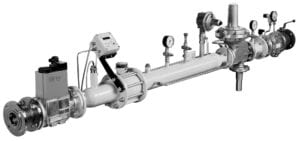 Natural gas is a world-wide low CO2 emitting, affordable carbon fuel source. Within the Southern African context, natural gas is used in domestic, commercial, industrial and specialised environments.
Natural gas is a world-wide low CO2 emitting, affordable carbon fuel source. Within the Southern African context, natural gas is used in domestic, commercial, industrial and specialised environments.
Established in 2009, the Pressure Equipment Regulations (PER) was introduced in South Africa to the natural gas market with the expectation that this regulation will ensure safety of use and good practise. PER regulates natural gas, amongst other gases and this regulation requires all equipment to be verified by a designated institution before placing in the market.
There are two institutions that verify natural/methane rich gas and liquefied petroleum gas equipment being the Southern African Gas Association (SAGA), and the Liquefied Petroleum Gas Safety Association of Southern Africa (LPGSASA).
While LPGSASA focuses on lower volumes of use found typically in domestic and commercial installations, SAGA‘s mandate is to regulate the safety of natural/methane rich and liquefied petroleum gas in industrial installations with gas volumes above a threshold of 0.5 gigajoules per hour or 10 kg per hour in terms of LPG, or 140 kilowatts per hour in terms of heat.
South African regulation role-players
In order to enforce the regulation issued through the chief inspector of the Department of Labour (DoL), SAGA has created policies and rules that govern safe gas handling for natural gas and liquefied petroleum gas.
In an essence, it’s illegal for a company to install, sell or take to market any natural gas/liquefied petroleum gas product, if the equipment is not registered or verified by SAGA. The DoL, Department of Trade and Industry, Customs and SARS play a vital role in enforcing these policies and rules.
This regulation scheme is further aided by SAGA on ground level, ensuring that natural gas practitioners, users and providers adhere to the PER. Through ongoing educational training courses, as well as public engagements, SAGA imprints its importance in the policing and safe handling of natural and liquefied petroleum gas within Southern Africa.
Operating under regulation for the safety of all
As South Africa has limited access to its own natural gas reserves, the country becomes reliant on importing. The majority of the natural gas available in South Africa is supplied from a few key import sources. Mozambique, for example, contributes to a significant amount of natural gas via pipeline.
Another example is through the network of South African harbours. Transporting natural gas via shipping is envisaged to explode into a rapidly expanding industry. As the demand increases, a large amount of new importers from Asia and Europe are entering the market. These importers largely participate in good practise of safe handling, but there are suppliers importing equipment for use in the natural gas/methane rich and liquefied petroleum gas natural gas environments who are not complying to the pressure equipment regulations.
In 2009 South Africa consumed 191 Bcf (5.4 Bcm) of natural gas, and this figure has grown substantially over the last seven years. It is up to SAGA to ensure the safe handling of natural/methane rich gas and liquefied petroleum gas from import to installation. Companies that work with gas should operate under regulation. This is vital as serious harm could be caused by negligent gas practise or handling.
 Natural gas is a world-wide low CO2 emitting, affordable carbon fuel source. Within the Southern African context, natural gas is used in domestic, commercial, industrial and specialised environments.
Natural gas is a world-wide low CO2 emitting, affordable carbon fuel source. Within the Southern African context, natural gas is used in domestic, commercial, industrial and specialised environments.






